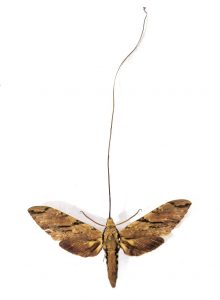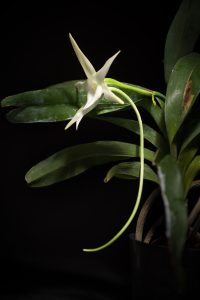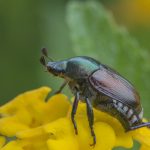A Short Post on Long Puzzles

 As mentioned in Theresa’s post about hummingbirds and cardinal flowers, many plants and animals have evolved together in a mutually-beneficial manner. This interaction between plants and animals, and more specifically invertebrates, was first articulated by—you guessed it—Charles Darwin. Darwin’s theory of evolution by natural selection accounts naturalistically for the variety of flora and fauna present on earth, but he also observed how these diverse organisms evolved together. First mentioning it in On the Origin of Species and subsequently developing the idea in 1862 in Fertilisation of Orchids, Darwin puzzled over the extensive 11.5-inch-long nectar spur of the Star of Bethlehem Orchid (Angraecum sesquipedale, later also known as Darwin’s Orchid). The problem here is that nectar’s function is to attach pollinators, but there wasn’t any knowledge of an animal with a proboscis long enough to reach the sugary snack. Darwin, leaning on the solid foundation of his evolutionary theory, predicted that because the long nectar spur existed, an insect with the requisite long “tongue” must also exist. Alfred Russel Wallace, Darwin’s contemporary and co-discoverer of natural selection, predicted in 1867 that the moth would be of the African sphinx variety. In 1903, twenty years after Darwin’s death, Morgan’s sphinx moth (Xanthopan morganii) was discovered in Madagascar, a moth with a sufficiently long proboscis.
As mentioned in Theresa’s post about hummingbirds and cardinal flowers, many plants and animals have evolved together in a mutually-beneficial manner. This interaction between plants and animals, and more specifically invertebrates, was first articulated by—you guessed it—Charles Darwin. Darwin’s theory of evolution by natural selection accounts naturalistically for the variety of flora and fauna present on earth, but he also observed how these diverse organisms evolved together. First mentioning it in On the Origin of Species and subsequently developing the idea in 1862 in Fertilisation of Orchids, Darwin puzzled over the extensive 11.5-inch-long nectar spur of the Star of Bethlehem Orchid (Angraecum sesquipedale, later also known as Darwin’s Orchid). The problem here is that nectar’s function is to attach pollinators, but there wasn’t any knowledge of an animal with a proboscis long enough to reach the sugary snack. Darwin, leaning on the solid foundation of his evolutionary theory, predicted that because the long nectar spur existed, an insect with the requisite long “tongue” must also exist. Alfred Russel Wallace, Darwin’s contemporary and co-discoverer of natural selection, predicted in 1867 that the moth would be of the African sphinx variety. In 1903, twenty years after Darwin’s death, Morgan’s sphinx moth (Xanthopan morganii) was discovered in Madagascar, a moth with a sufficiently long proboscis.
Photos sourced from Wikimedia Commons






